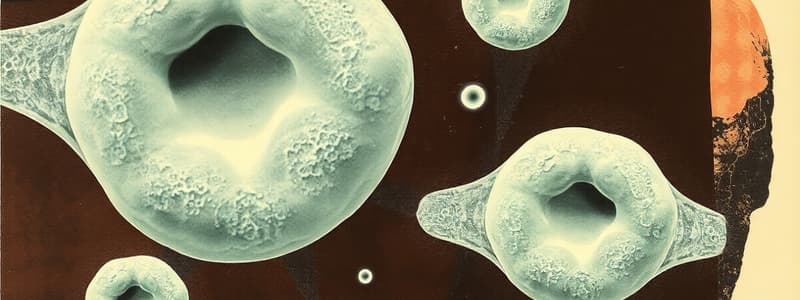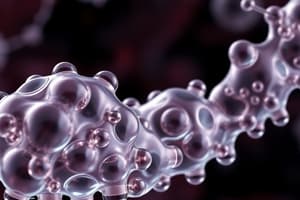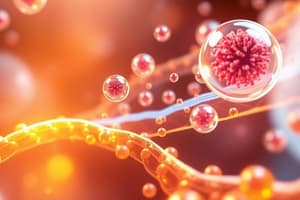Podcast
Questions and Answers
Which type of lipid is primarily solid at room temperature?
Which type of lipid is primarily solid at room temperature?
- Tristearin (correct)
- Olein
- Saponified oil
- Linoleic acid
What is the general formula for fatty acids?
What is the general formula for fatty acids?
- R-OH
- R-C(=O)OH
- R-COOH (correct)
- R-CH2-COOH
What type of fatty acids are commonly found in natural lipids?
What type of fatty acids are commonly found in natural lipids?
- Odd chain fatty acids with carbon numbers ranging from 3C to 5C
- Even chain fatty acids with typically 14 to 20 carbon atoms (correct)
- Saturated fatty acids with more than 20 carbon atoms
- Polyunsaturated fatty acids with less than 10 carbon atoms
Which of the following is primarily a source of dietary triglycerides?
Which of the following is primarily a source of dietary triglycerides?
What is the result of the hydrolysis of waxes?
What is the result of the hydrolysis of waxes?
What property distinguishes saturated fatty acids from unsaturated fatty acids?
What property distinguishes saturated fatty acids from unsaturated fatty acids?
Which classification of fatty acids refers to those that the body cannot synthesize and must be obtained from the diet?
Which classification of fatty acids refers to those that the body cannot synthesize and must be obtained from the diet?
Which fatty acid is classified as having 18 carbon atoms?
Which fatty acid is classified as having 18 carbon atoms?
What characteristic of unsaturated fatty acids is most commonly found in their double bonds?
What characteristic of unsaturated fatty acids is most commonly found in their double bonds?
What class of fatty acids contains fatty acids that are either short, medium, or long based on chain length?
What class of fatty acids contains fatty acids that are either short, medium, or long based on chain length?
Flashcards
Lipids
Lipids
Organic substances that are relatively insoluble in water but soluble in organic solvents.
Triglycerides (TG)
Triglycerides (TG)
Also called Triacylglycerols (TAG), they are esters of glycerol and 3 fatty acids.
Fatty Acids
Fatty Acids
Aliphatic monocarboxylic organic acids with a hydrocarbon side chain, mainly occurring as esters in fats and oils.
Saturated Fatty Acids
Saturated Fatty Acids
Signup and view all the flashcards
Unsaturated Fatty Acids
Unsaturated Fatty Acids
Signup and view all the flashcards
Fatty acid structure
Fatty acid structure
Signup and view all the flashcards
Fatty acid solubility
Fatty acid solubility
Signup and view all the flashcards
Types of unsaturated fatty acids
Types of unsaturated fatty acids
Signup and view all the flashcards
Study Notes
Lipids
- Lipids are organic substances that are relatively insoluble in water but soluble in organic solvents like chloroform, ether, and benzene.
- Lipids have diverse structures, mainly composed of carbon, hydrogen, and some polar atoms/functional groups.
- They are more similar based on their physical rather than chemical properties.
Biological Importance of Lipids
- Lipids are more palatable and storable than carbohydrates.
- They have a high energy value (25% of body needs), providing 9 kilocalories per gram, more than carbohydrates (4 kilocalories per gram) and proteins.
- Lipids supply essential fatty acids the body cannot synthesize.
- Lipids deliver fat-soluble vitamins (A, D, E, and K).
- They form vital components of the nervous system and cell membranes.
- Tissue fat is a crucial structural element in cells and nerves, primarily composed of phospholipids.
- Stored lipids ("depot fat") function as:
- Energy reserves (triglycerides).
- Cushioning for internal organs.
- Insulation against heat loss.
- Lipids are essential for producing hormones, vitamin D3, and bile acids.
- Lipoproteins (complex lipids and proteins) are crucial components of cellular and subcellular membranes.
Classification of Lipids
- Lipids are classified into three main types:
- Simple lipids,
- Complex lipids, and
- Derived lipids.
Simple Lipids
- Simple lipids are composed of fatty acids and alcohol. Examples include:
- Neutral fats (triglycerides):
- Glycerol + 3 fatty acids.
- Can be solid (fats) or liquid (oils), depending on the fatty acids.
- Waxes:
- Long-chain fatty acid + long-chain alcohol.
- Solid at room temperature.
- Examples include beeswax.
- Neutral fats (triglycerides):
Neutral Fats or Oils
- Fats and oils are also known as triglycerides.
- They are esters of glycerol and three fatty acids. A triglyceride is also called a triacylglycerol (TAG).
- Fatty acids have various lengths and degrees of saturation.
Types of Triglycerides (TAGs)
- Simple triglycerides: all three fatty acids are of the same type.
- Mixed triglycerides: the three fatty acids are of different types.
- Physical Classification:
- Fats are solids at room temperature, usually containing a higher proportion of saturated fatty acids.
- Oils are liquid at room temperature, often rich in unsaturated fatty acids.
Fatty Acids
- Fatty acids are aliphatic monocarboxylic organic acids with hydrocarbon side chains.
- They are insoluble in water.
- General formula (R-COOH):
- R represents the alkyl/hydrocarbon chain.
- COOH represents the carboxyl group.
- Fatty acids that occur naturally in lipids predominantly have an even number of carbon atoms (usually 14 to 20).
- Palmitic acid (16C) and stearic acid (18C) are the most common. -Propionic acid (3C) and valeric acid (5C) are examples of odd-chain fatty acids.
- Fatty acids are amphipathic, with a hydrophilic (polar) carboxyl head and a hydrophobic (nonpolar) hydrocarbon tail.
- Solubility depends on the length of the hydrocarbon chain.
- Classification:
- Based on the length of the carbon chain (short, medium, and long).
- Based on the degree of saturation (saturated, unsaturated—mono or poly).
- Based on the biological value (essential or non-essential).
- Based on the structure of the hydrocarbon chain (aliphatic, branched, cyclic).
Saturated fatty acids
- Contain only single bonds in their hydrocarbon chains.
- Typically solid at room temperature.
- Examples:
- Acetic acid, Butyric acid, Caproic acid, Caprylic acid, Capric acid, Lauric acid, Myristic acid, Palmitic acid, Stearic acid, Arachidic acid, Behenic acid
Unsaturated fatty acids
- Contain one or more double bonds in their hydrocarbon chains.
- Typically liquid at room temperature.
- Monounsaturated fatty acids:
- One double bond.
- Examples: Oleic acid, Palmitoleic acid, Elaidic acid
- Polyunsaturated fatty acids (PUFA's):
- More than one double bond.
- Omega-3 fatty acids
- Examples: Alpha-linolenic acid (ALA), Eicosapentaenoic acid (EPA), Docosahexaenoic acid (DHA)
- Omega-6 fatty acids
- Examples: Linoleic acid (LA), Arachidonic acid (AA)
Types of Omega 3 and Omega 6 Fatty Acids
- Omega-3 fatty acids
- Alpha-linolenic acid (ALA)
- Eicosapentaenoic acid (EPA)
- Docosahexaenoic acid (DHA)
- Omega-6 fatty acids
- Linoleic acid (LA)
- Arachidonic acid (AA)
Chemical Properties of TAGs
- Hydrogenation: Unsaturated fats react with hydrogen (H2) in the presence of a catalyst (Ni or Pt) and heat to form saturated fats. This process is used to create margarine, a semi-solid fat, from liquid vegetable oils.
- Saponification: Hydrolysis with a strong base (e.g., NaOH or KOH) breaks down triglycerides into glycerol and salts of fatty acids (soaps).
Rancidity
- Rancidity is the process of deterioration in fats and oils due to oxidation and hydrolysis. This can happen when fats or oils are exposed to light, air, moisture, or bacteria. The result is an unpleasant taste and odor.
- Hazards:
- The byproducts can be toxic, leading to food poisoning or cancer.
- Vitamins A, D, K, and E, as well as polyunsaturated fatty acids, can be destroyed.
- Rancidity may lead to economic losses as the product becomes unsafe and undesirable for consumption.
Prevention of Rancidity
- Avoid factors that cause rancidity. Examples include exposure to light, oxygen, moisture, high temperatures, and contamination from bacteria/fungi.
- Removing catalysts like lead and copper that promote rancidity.
- Incorporating antioxidants to prevent fat oxidation. Examples of common antioxidants include vitamin E, phenols, tannins, and hydroquinones.
Lipid Peroxidation
- Lipid peroxidation is a chain reaction that damages cell membranes.
- This occurs through several steps:
- Initiation: A free radical initiates the reaction.
- Propagation: The radical continues to damage lipids, creating more radicals.
- Termination: The chain reaction stops when radicals react with each other.
Branched Fatty Acids
- These fatty acids are not common in most food sources but are associated with certain diseases.
- Examples: Phytanic acid
Refsum's disease
- An autosomal recessive neurological disorder characterized by impaired α-oxidation of phytanic acid.
- Leading to the accumulation of phytanic acid in body tissues.
Cis and Trans Fatty Acids
- Cis fatty acids have hydrogen atoms on the same side of the double bond.
- Trans fatty acids have hydrogen atoms on opposite sides of the double bond.
Studying That Suits You
Use AI to generate personalized quizzes and flashcards to suit your learning preferences.




